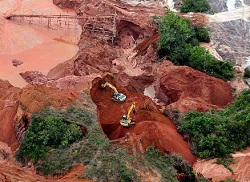The vast majority of gold in Colombia’s mines is extracted illegally, according to one expert, underscoring the importance of this illegal economy as the country prepares for a new chapter in its criminal history.
Eighty-eight percent of the 57 metric tons of gold that are mined each year in Colombia are produced illegally, the president of the Colombian Mining Association (Asociación Colombiana de Minería – ACM) Santiago Ángel Urdinola said at a recent press conference.
Urdinola said that the departments with the highest percentage of illegally mined gold are Chocó, Cauca and Valle del Cauca on the Pacific coast, as well as Antioquia and Caldas, RCN Radio reported.
The ACM president said that although there were no official figures on the profits generated from illegal mining, he believes that they are “astronomical.” These activities do not pay taxes to the state and do not comply with environmental regulations, he added.
SEE ALSO: Coverage of Mining
Urdinola also expressed hope that the national government would quickly finalize a new bill that aims to tighten controls on illegal gold extraction and remove the judicial ambiguities within the industry.
“The illegal industry has been growing, in part due to the lack of controls,” Uridinola said.
The Colombian news outlet Portafolio, citing ACM and government figures, reported in June that only 18 percent of all the gold produced and exported in Colombia last year was done using official mining titles. Much of the illicit gold enters the legal market in Antioquia and Valle del Cauca and is worth around $2.3 billion per year, according to Portafolio.
InSight Crime Analysis
The recent statistics on illegal gold mining demonstrate how pivotal this criminal industry is to Colombia’s organized criminal landscape, which may grow in importance in the near future.
Mining is a key source of income for Colombia’s guerrilla organizations and neo-paramilitary groups, known as BACRIM (from the Spanish “bandas criminales”). These groups manage, extort and provide security for illegal mining operations. The departments with the most gold deposits — which include Chocó, Antioquia, Córdoba, Bolívar and Cauca — are also some of the country’s most violent, with a heavy presence of armed actors.
SEE ALSO: Coverage of Gold
Indeed, in departments such as Chocó, gold is potentially a bigger source of criminal revenue than coca crops, the main ingredient for cocaine. This balance is in constant flux. As global gold prices ebb and flow, so too does the mineral’s role in Colombia’s illegal economy. By 2012, surging gold prices helped it become the main source of earnings for criminal groups in around a quarter of Colombia’s 32 departments. The value of gold then plummeted, and coca cultivation has since experienced a resurgence, reaching its highest levels in years.
Given this trend, the recent rise in the value of gold — apparently brought on by the United Kingdom’s vote to leave the European Union — is worrying. Colombia’s criminal underworld is already experiencing a deep shift in power with the looming prospect of a guerrilla demobilization by the Revolutionary Armed Forces of Colombia (Fuerzas Armadas Revolucionarias de Colombia – FARC), which controls a large portion of the country’s coca fields and illegal mines. These mineral deposits promise to attract rival armed actors looking to fill the void left by the guerrillas if and when they sign a peace deal with the Colombian government.

